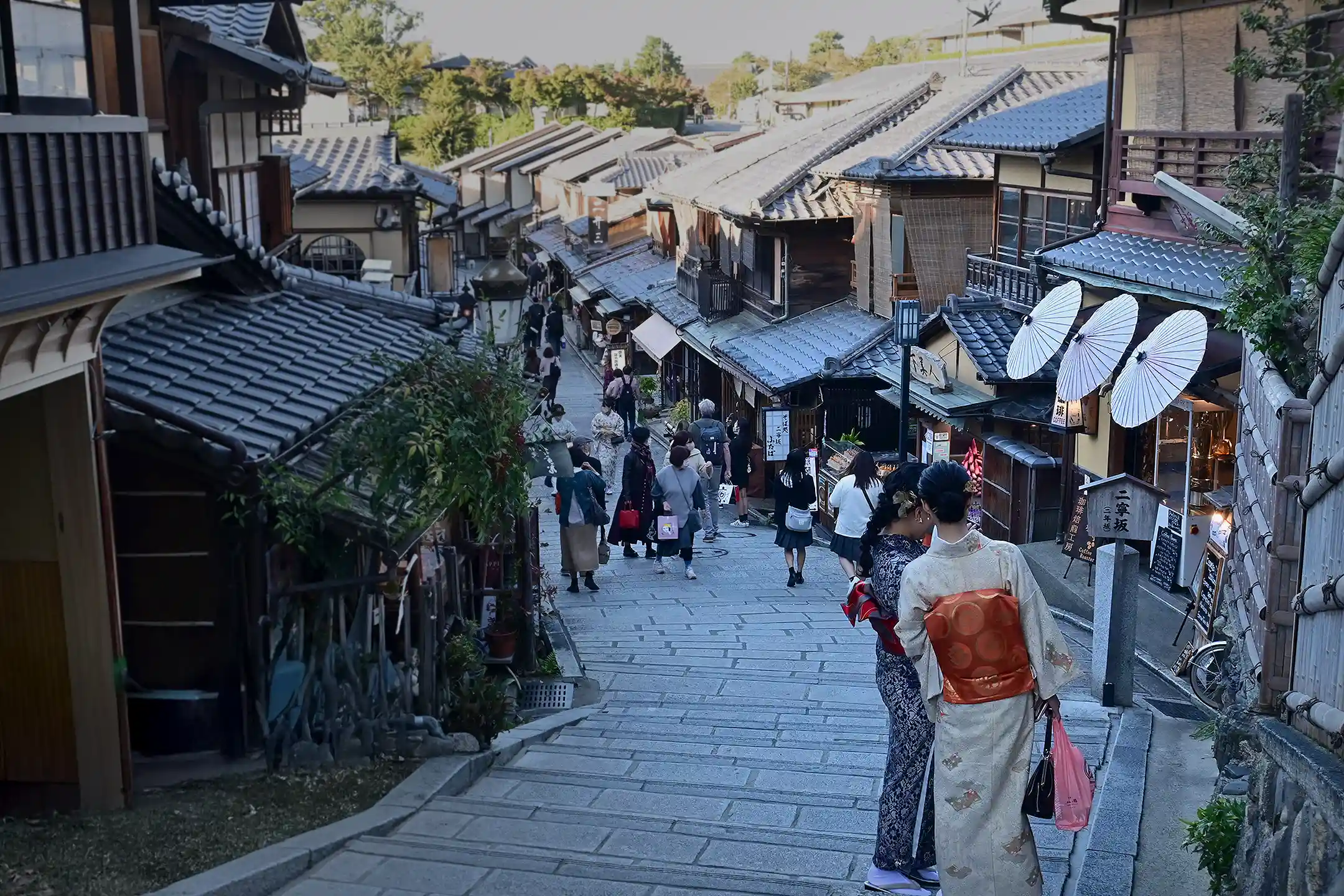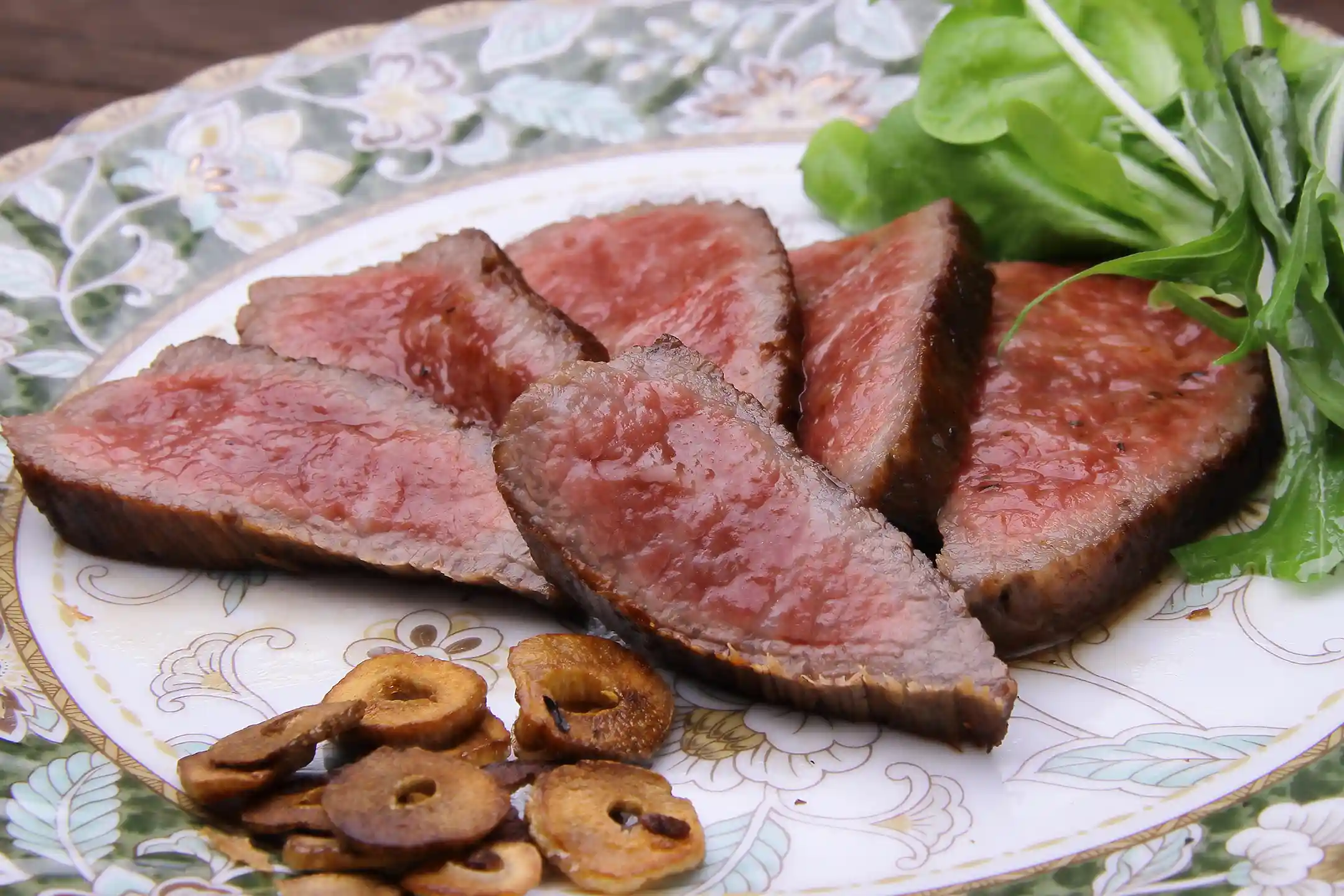Kyoto is a beautiful city where history and culture intertwine seamlessly. Its true charm is best experienced by walking through its streets and immersing yourself in the Kyoto old town atmosphere. As you stroll, you can explore the atmospheric geisha district of Gion and the quiet lanes of Higashiyama—areas that epitomize old Kyoto charm.
You can also discover the living craft traditions of Nishijin, feel the harmony of past and present around Nijo Castle, and wander from the Philosopher’s Path to the cultural hub of Okazaki. In this article, we introduce several walking routes that immerse you in Kyoto’s sophisticated culture and art, inviting you on an exceptional journey.
Historic Streets of Gion & Higashiyama: The Heart of Kyoto’s Old Town
Gion, Kyoto’s famous geisha district, and the nearby Higashiyama area provide a perfect setting for you to experience the timeless charm of Japan’s ancient capital. Here, geiko (geisha) and maiko (apprentice geisha) still glide gracefully along stone-paved alleys lined with traditional Kyoto townhouses, preserving the city’s cultural heritage before your eyes.
Interestingly, the name “Gion” comes from Gion-sha, the old name of Yasaka Shrine. This district has been dotted with traditional tea houses since the Edo period and was designated the “Gion Shinbashi Traditional Building Preservation District” in 1976 (*1). Just one lane away from the bustling Shijo Street, a tranquil world unfolds. As you wander down these quiet, stone-paved paths, you might catch the distant sound of shamisen music and your own footsteps echoing off the tiles—an almost nostalgic soundtrack that makes you feel as if you’ve slipped back in time.
Walking Hanamikoji Street to Immerse in Maiko Culture and Kyoto’s Traditional Townhouses
Hanamikoji Street, with its signature stone paving, is one of Gion’s quintessential streets. In 2002, all the overhead utility wires were buried underground and granite paving was laid, restoring the street’s historic beauty (*2).
As you walk along, you’ll notice traditional Kyoto-style machiya (townhouses) on both sides, housing exclusive tea houses and restaurants. At dusk, soft lantern light glows through wooden lattice doors, creating a magical atmosphere. Unlike the bustling nightlife districts you may know from abroad, many of Gion’s tea houses are by invitation only—a sign of their exclusivity and storied prestige. During the day, you can step inside charming souvenir shops set in renovated townhouses, discovering Kyoto’s elegant balance of tradition and contemporary style through local sweets and crafts.
If you’re lucky, you might catch sight of a maiko in her vivid kimono heading to an evening engagement (*1). It’s easy to be enchanted by her striking beauty, and knowing that these young women are highly trained in traditional arts makes the encounter even more meaningful. Strolling down Hanamikoji Street lets you experience the living tradition of machiya architecture and maiko culture, offering a profound insight into Kyoto’s heritage.
Zen Gardens and Tranquility at Kennin-ji and Kodai-ji Temples
The temples around Gion are must-visit spots on any historical stroll. If touring the majestic cathedrals of Europe leaves you in awe of their grandeur, visiting Kyoto’s Zen temples will surround you with a sense of serenity and harmony instead.
Kennin-ji Temple, established in 1202 by the monk Eisai as Kyoto’s first Zen temple, houses numerous treasures. Among them are a meticulously raked dry rock garden and the famous “Wind and Thunder Gods” folding screen paintings by Tawaraya Sotatsu, which are designated as Important Cultural Properties (*3). These minimalist rock gardens encapsulate Zen philosophy perfectly, leaving a deep impression on visitors.
Kodai-ji Temple, founded in 1606 by Nene (the widow of warlord Toyotomi Hideyoshi), exudes a quiet yet powerful atmosphere of prayer and reflection. The temple’s strolling garden—created by master gardener Kobori Enshu and designated as a nationally recognized scenic beauty—offers you a mystical, contemplative landscape to enjoy (*4).
Discover Hidden Pottery and Traditional Craft Galleries in Higashiyama
Beyond the famous temples, the Higashiyama area also hides several lesser-known craft gems. One such gem is the Kawai Kanjiro Memorial Museum near Kiyomizu Temple, which preserves the early 20th-century home and studio of pottery artist Kanjiro Kawai—complete with his climbing kiln and original 1937 furnishings. The warm, lived-in atmosphere here is very different from a typical Western art museum, giving you an intimate glimpse into the artist’s daily life.
Just a short walk away on Sannenzaka slope, you’ll find the Kiyomizu Sannenzaka Museum. Here you can marvel at exceptional crafts such as cloisonné enamelware and lacquerware from the late Edo to Meiji eras—masterpieces that once astounded the world with their artistry (*5).
Nishijin & Kamishichiken: A Stroll through Artisan Traditions and Geiko Culture
A stroll from Nishijin—renowned for its silk weaving tradition—to Kamishichiken, Kyoto’s oldest geisha district, immerses you in a world of artisan craftsmanship and geiko culture. In this part of the city, you can delve into Kyoto’s living heritage as you wander from the clacking wooden looms of Nishijin to the refined teahouses of Kamishichiken.
The Nishijin area has been a center of weaving since the Heian period and even takes its name from serving as the western army’s base during the Onin War. Unlike many textile centers that survive only as museums, Nishijin is a living district where centuries-old weaving traditions are still part of daily life. It’s a vivid example of how Kyoto preserves tradition within everyday city living.
Nishijin silk, designated as a national traditional craft in 1976, features intricate designs woven from pre-dyed silk threads. It’s acclaimed worldwide for its exquisite quality and the beautiful patterns achieved through diverse weaving techniques (*1).
A Cultural Walking Route through Nishijin’s Artisan Streets
In Nishijin, you can feel the history of weaving all around you. The neighborhood’s grid-like streets are dotted with former weavers’ houses and workshops, and you can visit the Nishijin Textile Center where skilled artisans demonstrate traditional weaving techniques right before your eyes. You might even have the chance to dress up in a Nishijin silk kimono, experiencing the elegance of Kyoto’s textile heritage firsthand, and shop for beautiful fabrics directly from the artisans themselves.
Experience Traditional Performing Arts in Historic Kamishichiken
Continue north to Kamishichiken, and you’ll find yourself in Kyoto’s oldest geisha district (*2). This area is famous for its elegant seasonal performances, such as the springtime Kitano Odori dance revue. Here, you can savor traditional sweets and matcha tea at the charming Sharon Kanazono Teahouse in Kamishichiken, enjoying a quiet moment that stands in stark contrast to a typical bustling nightlife scene (*3).
Nijo Castle Area: A Stroll through Historic Architecture and Modern Culture
Around Nijo Castle—an iconic site marking the dawn of the Edo period—you can enjoy a walk that beautifully blends the grandeur of historic architecture with the flair of modern cultural spots set in renovated townhouses. If the grand castles of Europe evoke images of medieval battles, Kyoto’s Nijo Castle offers a uniquely peaceful power, combining the authority of samurai clans with the elegance of refined court culture.
A registered World Heritage Site, Nijo Castle (including its grounds) was built by Tokugawa Ieyasu in 1603 as a residence for the shogun when he visited Kyoto and as a fort to guard the Imperial Palace. Shogun Iemitsu later expanded it, and today the castle’s Ninomaru Palace stands as a superb example of Shoin-zukuri architecture. Nearly 400 years later, you can still marvel at stunning Momoyama-period relics here—from the expansive Ninomaru Garden to the ornate Karamon Gate.
Discovering the History and Architectural Beauty of Nijo Castle
When you visit Nijo Castle, there are several highlights no history buff or architecture lover should miss. The castle’s Ninomaru Palace is actually a series of six interlinked buildings in lavish Shoin-zukuri style. Inside, you’ll find tatami-floored rooms adorned with intricately carved wooden transoms and walls decorated with paintings accented in gold leaf. Some of the most impressive artworks are the sliding door panels, like the famous “Pine and Hawk” and “Cherry Blossoms” paintings, which vividly showcase the splendor of the Azuchi-Momoyama period.
Be sure to take your time admiring the fine details — the elaborate wood carvings and decorative metal fittings in the Ninomaru Palace, as well as the magnificent Karamon Gate at the entrance. In Japanese castles, the building itself (rather than any movable furniture) is considered a work of art. If you sit on the tatami mats and quietly observe the painted screens and woodwork around you, you can almost feel the aesthetic sensibilities of that era.
Just outside, the Ninomaru Garden—one of Japan’s finest strolling gardens—offers beautiful views in every season, from spring cherry blossoms to autumn maples. Nijo Castle is also very visitor-friendly, with English signs and pamphlets that make it easy to understand the history as you explore. Taking your time to wander the grounds and reflect on Japan’s past can be a highlight of your Kyoto visit..webp?width=750&height=500&name=Karamon%20Gate%20of%20Nijo%20Castle%20(or%20Nijo-jo%20Castle).webp)
Experience Kyoto’s Modern Spaces in Renovated Machiya Cafés
In the streets near Nijo Castle, you’ll find an array of stylish cafés and galleries that have breathed new life into old machiya townhouses. This area was once full of samurai residences and merchant homes, and many of those traditional wooden buildings still stand today. Now, a number of them have been thoughtfully renovated into contemporary spaces like coffee shops, art galleries, and boutiques.
Kyoto’s machiya cafés seamlessly blend classic Japanese aesthetics with modern design, creating an ambiance that is both serene and chic. From the street, they still look traditional with their wooden lattice and earthen walls, but inside you’ll find sleek modern touches that provide comfort. This way, you enjoy the atmosphere of old Kyoto without sacrificing any modern convenience. This harmonious blend of old and new has made the machiya themselves attractions in their own right and even revitalized the neighborhood’s peaceful character (*1). When you visit Nijo Castle, be sure to pause at a machiya café and savor that uniquely Kyoto mix of historic ambiance and modern elegance.
Philosopher’s Path to Okazaki: An Enriching Cultural Walk
Eastern Kyoto — stretching from Ginkaku-ji Temple down to Nanzen-ji Temple — is an intellectually stimulating area brimming with lush walks and cultural treasures. A centerpiece of this district is the famed Philosopher’s Path. This stone-paved trail, named after a philosophy professor who strolled it daily for contemplation in the early 20th century, becomes a tunnel of cherry blossoms each spring. It runs about two kilometers and ranks among Japan’s most beloved walks. The very idea of walking a “philosopher’s path” is enchanting, and you might find it sparks your own curiosity and sense of wonder as you meander along.
The path follows a gentle stream, and as you walk you’ll encounter seasonal delights: pink blossoms and fresh greenery in spring, and even fireflies flitting above the water on summer evenings. Quiet temples and shrines dot the route — some adorned with monuments to writers and philosophers — and pausing at these peaceful spots can deepen your appreciation of Kyoto’s cultural layers.
Kyoto’s Culture and Literature Along the Philosopher’s Path
The Philosopher’s Path runs from Ginkaku-ji down to near Nyakuoji Shrine, and it’s famous for its changing beauty in every season. In spring, the route is especially enchanting — hundreds of Kansetsu cherry trees (donated by the painter Hashimoto Kansetsu) burst into magnificent bloom (*1). Come autumn, the surrounding maples turn fiery shades of red and gold, and even in winter a light dusting of snow can transform the path into a quiet, poetic scene. No matter when you visit, there’s always some scenic charm to enjoy.
As you wander along, you’ll even come across the former residences of renowned writers like Naoya Shiga and Junichiro Tanizaki, which offer a tangible connection to Kyoto’s literary heritage. The path is also lined with little art galleries, antiquarian bookshops, and cozy cafés. These quiet spots are perfect for connecting with fellow art and book lovers. Taking a moment to chat in a bookshop or linger over tea can become a heartwarming travel memory. A leisurely stroll along the Philosopher’s Path encourages reflection and reveals yet another facet of Kyoto’s charm.
Modern Art Museums in Okazaki: Blending Tradition and Innovation
Head south from the Philosopher’s Path toward Okazaki Park, and you’ll find yourself surrounded by some of Kyoto’s best cultural institutions. Kyoto is of course famous for its temples and shrines, but this district will surprise you with a vibrant contemporary art scene that adds a whole new dimension to the city’s appeal.
One highlight is the National Museum of Modern Art, Kyoto, which showcases artwork from western Japan across many mediums — paintings, prints, ceramics, sculpture, photography, and even modern design (*2). With a collection of roughly 13,000 pieces, this museum beautifully blends traditional Kyoto craftsmanship with modern artistic expression.
Just nearby, the recently renovated Kyoto City KYOCERA Museum of Art (originally opened in 1933) retains its elegant historic façade while offering modern, spacious galleries inside. This fusion of preserved architecture with state-of-the-art exhibition space exemplifies Kyoto’s commitment to honoring tradition while embracing innovation.
The Okazaki area also features a lovely zoo, a public library, and the iconic Heian Shrine, so you can easily spend a whole afternoon exploring here. Consider taking a break at a neighborhood café between museum visits to jot down your thoughts or simply relax — little moments like these make your Kyoto experience even more memorable.
A New Approach to Sustainable Travel: Eco-Friendly Strolls Through Kyoto’s Historic Streets
Exploring Kyoto’s deeply traditional streets becomes even more rewarding when you do it sustainably. Many people imagine Kyoto purely as an ancient city, so you might be surprised at how enthusiastically it has adopted cutting-edge sustainability initiatives.
Kyoto has managed to balance preservation of its heritage with a spirit of innovation. Even in a city known for narrow, centuries-old alleyways, quiet and clean modes of transport are finding their place, blending into the historic scenery and benefiting both locals and visitors by reducing noise and pollution.
In recent years, the city has accelerated its efforts toward sustainable tourism by introducing eco-friendly options across various aspects of travel — from greener public transportation to environmentally conscious hotels (*1). Below, let’s look at how you can get around Kyoto using electric vehicles and other eco-friendly transport, and how you can stay in comfort at hotels that prioritize sustainability.
Exploring Historic Districts with Electric Vehicles and Eco-Friendly Transportation
Choosing eco-friendly transportation in Kyoto can enhance your experience in unexpected ways. For example, in 2021 the city introduced fully electric buses on one of its main routes (running between Kyoto Station, Shichijo, and Umekoji), converting the entire line of four buses to zero-emission vehicles — a first for Japan (*1).
These quiet, emission-free buses blend effortlessly into Kyoto’s old-world atmosphere, letting you enjoy the sights without engine noise or exhaust fumes. And some upscale hotels even provide electric cars for their guests. Exploring by electric car is convenient, and you’re minimizing your environmental impact as you navigate Kyoto’s historic streets. You might also consider renting a bicycle or electric-assisted bike for a leisurely tour of Kyoto’s neighborhoods. Walking or cycling may even lead you to charming shrines or hidden cafés that you’d miss in a car. By opting for these eco-friendly ways to get around, you’ll tread more lightly on the environment and connect more intimately with local life.
Sustainable Hotels Offering a Comfortable Stay in Kyoto
Kyoto has seen a rise in hotels that seamlessly blend sustainability with comfort and luxury. Thanks to the meticulous omotenashi (hospitality) that Japan is known for, these eco-conscious practices are implemented so thoughtfully that you can participate in sustainability efforts without ever feeling your convenience is compromised.
For example, one hotel replaced plastic water bottles with dispensers on each floor and provided reusable tumblers (*2). Others reduce their environmental footprint by using renewable energy, sourcing local organic ingredients, or inviting guests on longer stays to skip daily linen changes.
Some newer Kyoto hotels have earned international recognition for their chic, eco-friendly design. They also celebrate local culture — displaying traditional crafts in their lobbies or hosting workshops for guests — so you can engage with Kyoto’s heritage while staying green.
By choosing a sustainable hotel, you can fully enjoy your Kyoto stay with peace of mind, knowing you’re helping to protect the environment. This added sense of purpose makes your journey even more rewarding.
Conclusion: Recommended Routes to Explore Kyoto’s Historic Streets
Strolling through Kyoto’s streets offers luxurious experiences defined by each area’s unique charm. Gion welcomes you with cobblestone lanes, geisha culture, and traditional machiya charm. The Nishijin and Kamishichiken area immerses you in masterful textile arts and graceful geisha performances. Around Nijo Castle, you can admire grand samurai-era architecture and then unwind at a chic machiya café. Finally, a leisurely walk along the Philosopher’s Path in Okazaki Park brings you art, nature, and seasonal beauty that invite quiet reflection.
Also consider Kyoto’s innovative touches, like eco-friendly transportation and sustainable hotels, to further enrich your journey. Ultimately, the best way to savor Kyoto’s charm is to find your own path — one that blends its deep history, rich culture, and commitment to sustainability into an unforgettable experience.
Author Bio





.webp)
.webp)